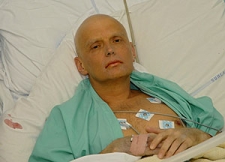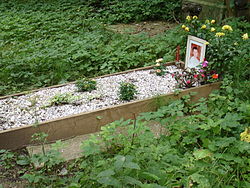| Poisoning of Alexander Litvinenko | |
|---|---|
 Litvinenko at University College Hospital | |
 Interactive map of Poisoning of Alexander Litvinenko | |
| Location | 51°30′38″N0°9′3″W / 51.51056°N 0.15083°W London |
| Date | 1 November 2006 |
| Target | Alexander Litvinenko |
Attack type | Poisoning |
| Weapon | Polonium-210 |
| Accused | Andrey Lugovoy and Dmitry Kovtun [1] [2] |
Alexander Litvinenko was an officer of the Russian Federal Security Service (FSB) and its predecessor, the KGB, until he left the service and fled the country in late 2000.
Contents
- Background
- Illness and poisoning
- Poison
- Thallium – initial hypothesis
- Death and last statement
- Investigation
- Initial steps
- Polonium trails
- British extradition request
- Extradition declined
- BBC programme
- UK inquiry
- Carter v. Russia (ECHR)
- Possibly related events
- Litvinenko photo as shooting target (Russia, 2002, 2006)
- Paul Joyal murder attempt (US, 2007)
- Suspicious death of radiation scientist (UK, 2016)
- Skripal assassination attempt (UK, 2018)
- Polonium-210
- Sources and production of polonium
- Possible motivation for using polonium-210
- Russian response
- Initial public comments
- Further response from Russia
- Suspects
- Other people related to the case
- Timeline
- Background history
- 2006
- 2007
- Comparisons to other deaths
- Deaths from ingesting radioactive materials
- Similar suspicious deaths and poisonings
- References in popular culture
- See also
- References
In 1998, Litvinenko and several other Russian intelligence officers said they had been ordered to kill Boris Berezovsky, a Russian businessman. [3] After that, the Russian government began to persecute Litvinenko. He fled to the UK, where he criticised the Russian President Vladimir Putin and the Russian government. [4] In exile, Litvinenko worked with British and Spanish intelligence, sharing information about the Russian mafia in Europe and its connections with the Russian government. [5]
On 1 November 2006, Litvinenko was poisoned and later hospitalised. He died on 23 November, becoming the first confirmed victim of lethal polonium-210-induced acute radiation syndrome. [3] [6] Litvinenko's allegations about misdeeds of the FSB and his public deathbed accusations that Putin was behind his poisoning resulted in worldwide media coverage.
Subsequent investigations by British authorities into the circumstances of Litvinenko's death led to serious diplomatic difficulties between the British and Russian governments. [7] In September 2021, the European Court of Human Rights (ECHR) ruled that Russia was responsible for the assassination of Litvinenko and ordered Russia to pay Litvinenko's wife €100,000 in damages plus €22,500 in costs. [8]
The ECHR found beyond reasonable doubt that Andrey Lugovoy and Dmitry Kovtun killed Litvinenko. The Court's decision is in line with the findings of a 2016 UK inquiry. [1] The UK concluded that the murder was "probably approved by Mr. [Nikolai] Patrushev, then head of the FSB, and also by President Putin." [9]

